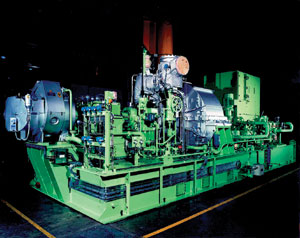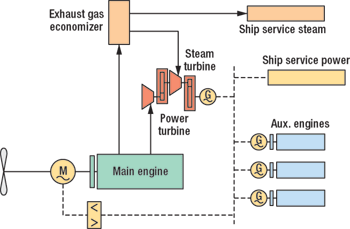Protecting the Environment
Substantial fuel savings for ships
A new waste heat recovery plant reduces exhaust emissions.
The new heat recovery plant is installed in the 7,000 TEU containership Gudrun Maersk, which entered service in June 2005. The waste heat recovery plant has been developed in a joint effort headed and integrated by Odense Steel Shipyard Ltd in cooperation with Wärtsilä Corp., Siemens AG, Peter Brotherhood Ltd and Aalborg Industries Ltd. During sea trials and in operations thus far, plant performance has exceeded expectations.
 |
Fig. 1. Brotherhood turbogenerator set for the Gudrun Maersk, with the exhaust-gas power turbine on the left, the generator on the right, and the steam turbine to the right of center.
|
|
The waste heat recovery plant follows the well-established concept of passing exhaust gases from the ship’s main engine through a heat exchanger to generate steam for a turbine-driven generator. This method further maximizes exhaust heat recovery. Engineers modified the engines to allow a lower air intake temperature, made available by drawing intake air from outside the ship instead of from the ship’s engine room. The engine turbochargers are matched for the lower air intake temperatures, thereby increasing the exhaust energy.
At the same time, the high-efficiency turbochargers have surplus capacity at the engine’s upper load range when matched for ambient air intake. This means that about 10% of the engine’s exhaust gas flow can be branched off to drive a power turbine that is incorporated in the turbogenerator package.
The result of the new concept is that the combined recoverable energy in exhaust-gas economizer and power turbine is increased without affecting airflow through the engine. Thus, there is no increase in thermal loading of the engine, and there is no adverse effect on engine reliability.
Heat is also recovered from the engine’s scavenge air and jacket-cooling water for feed-water heating. The scavenge air coolers are designed in such a way that the boiler feed water can be heated close to the evaporation temperature.
The electrical power generated is used to assist ship propulsion or to supply shipboard services. Such waste heat recovery plants can provide electrical output up to 12% of engine power. The power generated thus contributes significant savings in both fuel costs and overall exhaust-gas emissions, such as CO2, NOX, SOX, etc. It is the only commercially available technology that reduces fuel consumption and exhaust emissions at the same time. The payback time would depend on installation design/ cost and bunker fuel prices, but it should in general be less than five years, especially with today’s fuel prices.
The vessel is propelled by a Sulzer 12RT-flex96C low-speed common-rail engine, with a maximum continuous power output of 68,640 kW at 102 rpm. Exhaust gases pass through an Aalborg dual-pressure exhaust-gas economizer to generate superheated steam. The steam generates 6 MWe in a Peter Brotherhood turbogenerator set, which incorporates both a multi-stage, dual-pressure steam turbine and an exhaust-gas power turbine. The generated electricity is supplied to the ship’s main switchboard and used in a Siemens shaft motor/ generator to assist in ship propulsion and in shipboard services. A portion of the steam from the exhaust economizer is used in shipboard heating services.
The vessel is also equipped with three eight-cylinder Wärtsilä 32 generating sets, with a combined electrical output of 11.2 MWe. The calculated output of the turbogenerator set was based on ISO standard reference conditions that include an ambient temperature of 25°C. During sea trials, this performance was exceeded, as such output was already achieved at the ambient temperature of 14°C. Since delivery, the waste heat recovery plant has operated fully satisfactorily.
The main parts of the waste heat recovery plant were supplied by Siemens AG, Peter Brotherhood Ltd, and Aalborg Industries A/S, while Wärtsilä, as designer and licensor of Sulzer low-speed engines, cooperated in engineering and developing the waste heat recovery plant. 
 |
Fig. 2. Schematic of the waste heat recovery plant.
|
|
|




